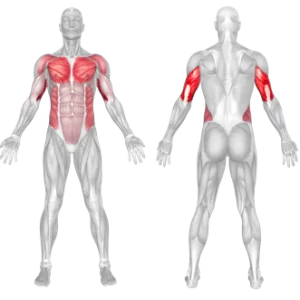WALL PUSH-UP OVERVIEW
The Wall Push-Up is a beginner-friendly variation of the classic push-up performed against a wall. This exercise targets the pectoralis major (chest muscles), triceps, and anterior deltoids
It’s an excellent choice for those new to strength training, individuals recovering from injuries, or anyone seeking a low-impact exercise option. Wall push-ups can also serve as a warm-up for more advanced push-up variations.
SETUP
Stand facing a wall, about 2–3 feet away, depending on your arm length.
Place your hands on the wall at shoulder height and slightly wider than shoulder-width apart.
Keep your body straight from head to heels, engaging your core to maintain a neutral spine.
Execution
- 1. Lowering Phase
- Slowly bend your elbows and lower your chest toward the wall, keeping your elbows at a 45-degree angle from your body.
- Stop when your chest is about an inch away from the wall.
- 2. Pressing Phase
- Push through your palms to straighten your arms, returning to the starting position.
- Keep your movements controlled and avoid locking out your elbows.
- 3. Repeat: Perform for the desired number of repetitions while maintaining good form.
| Muscle Groups |
|---|
|
Primary: |
|
✔️ Chest |
|
✔️ Triceps |
| Equipment |
|---|
|
✔️ Full Gym |
|
✔️ No Equipment |
TIPS FOR MAXIMUM EFFECTIVENESS
- Adjust Hand Placement: A wider grip emphasizes the chest, while a narrower grip targets the triceps more.
- Gradually Increase Difficulty: To progress, move your feet further from the wall or transition to incline or floor push-ups.
- Breathe Properly: Inhale as you lower yourself and exhale as you push away from the wall.
- Focus on Form: Prioritize good form over the number of repetitions to avoid injury and maximize results.
- Combine with Other Exercises: Pair wall push-ups with other bodyweight exercises like squats or lunges for a full-body workout.
COMMON MISTAKES TO AVOID
1. Beginner-Friendly
Perfect for those with limited upper body strength or just starting their fitness journey.
2. Low Impact
Gentle on the wrists, elbows, and shoulders, making it suitable for individuals with joint issues.
3. Improved Upper Body Strength
Strengthens the chest, arms, and shoulders, preparing you for more advanced push-up variations.
4. Core Engagement
Helps improve posture and stability by engaging the core muscles.
5. Scalable Exercise
Can be modified by adjusting the distance from the wall or changing the hand placement to increase or decrease difficulty.
6. Convenience
Requires no equipment and can be performed anywhere, making it accessible for all fitness levels.
COMMON MISTAKES TO AVOID

